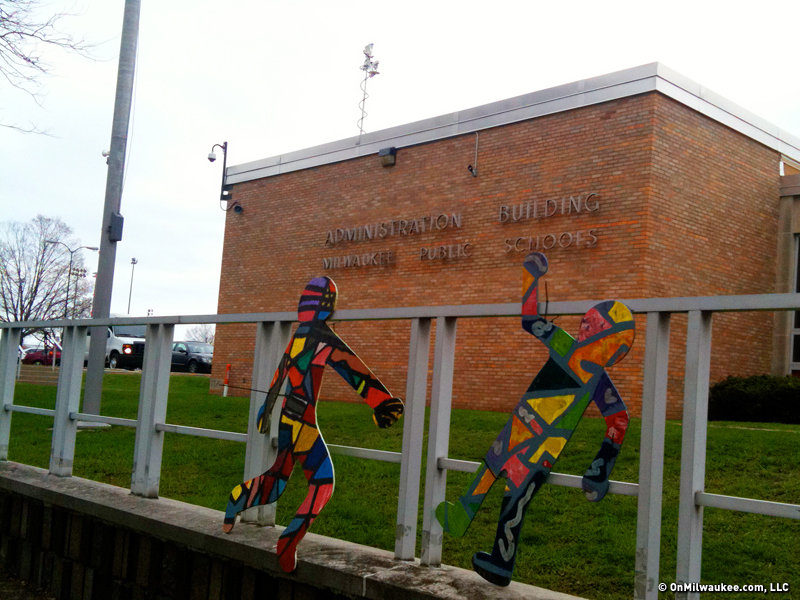The opinions expressed in this piece do not necessarily reflect the opinions of OnMilwaukee.com, its advertisers or editorial staff.
I finally got around to watching the "conversation" (moderator Alan Borsuk insisted it was not a "debate") between Republican State Rep. Dale Kooyenga and the executive director of the Milwaukee Public Schools' teachers union (MTEA), Lauren Baker, held a couple weeks ago at the Marquette University Law School.
As so often happens, this discussion of schooling in Wisconsin and Milwaukee was scheduled for a time when anyone directly involved in that schooling – parents, students, teachers – would not be available to attend or participate: the middle of a school day. Marquette does archive these, though, so like me you can watch the video after the fact if you haven't yet.
You probably know Kooyenga as one of the authors of the MPS takeover legislation known as the Opportunity Schools and Partnership Program, or OSPP. You probably also know that I oppose that legislation strongly, but trust the current efforts of those tasked with implementing it: Milwaukee County Executive Chris Abele and OSPP Commissioner Demond Means, who have promised to do so in a way that least affects the ability of MPS to fulfill its mission of teaching all children who come through their doors.
What struck me while watching Kooyenga defend not just OSPP, specifically, but his ideology in general was not the obvious absence of horns and a pointed tail, but rather the breathless sincerity with which he spoke of wanting all children to succeed. In doing so, he espoused the common belief among conservatives and Republicans that the focus of legislative and funding efforts should be not on schools or school systems, but on students.
"We should have a student-centered focus," Kooyenga said, "not a school-centered focus or a district-centered focus. When we have that money conversation, we're focused on funding of the districts. We need to focus on funding students."
This is the Milt Friedman school of educational thought. Friedman, an economist whose market-centered philosophy has deeply influenced the modern conservative movement, was an ardent early supporter of school vouchers. He believed that if parents had the power to choose where their children went to school – and the money to back up that decision – the "market" would ensure that good schools expanded and flourished while bad schools would fold up and disappear.
This market-based reform has been the norm in Milwaukee for 25 years, and I'll let you decide for yourself how well it's working.
But here's the thing about Kooyonga's insistence that money follow the student, and that reform and legislation should focus on the child rather than the schools or districts: Students don't learn in a vacuum.
I'm not merely talking about the 85 percent of a child's first 18 years when he or she is not physically in school, although that does have a serious effect on educational outcomes, obviously.
Rather, I'm talking about schools and school systems, the infrastructure both physical and human that delivers a child's education. As much as reformers of any stripe – both conservative pro-voucher types and liberal pro-charter types like Democrats for Education Reform – like to think that focusing only on students and worrying only about funding students whatever school they attend, the health and quality of that school and the system supporting that school is just as, if not more, important.
Consider that by far the best schools in the city's voucher program are those connected to larger systems – the Catholic and Lutheran schools that mostly were already in existence before vouchers were opened to religious schools in 1998. The flip side of that is the program's most spectacular failures have tended to be one-off startups unconnected to any larger support system.
Look at the city's charter schools, public schools supported by public funds and chartered by MPS, the city or the University of Wisconsin-Milwaukee. Again, the best of those schools have organizations behind them – Seeds of Health and La Causa being prime examples – that have records of success pre-dating their becoming part of the charter school program.
Voucher and charter schools that do well also have not just institutional support of pre-existing organizations, but major outside donor funding, as well, that goes above and beyond what comes to those schools through state payments for students. Even when that's the case, schools still sometimes end up in trouble with funding – as in the city's Rocketship charter, which is backed by a national charter chain and started in Milwaukee with millions in donor seed money – or student achievement – as in the city's North Point Lighthouse school, also backed by a national charter organization.
Merely giving parents a choice and letting the money follow the student is not enough if the places those students go aren't part of healthy school systems.
Even in MPS, where you find some of the state's best schools and most of the state's worst schools, success is not easy or magical. Consider the district's flagship International Baccalaureate high schools, Rufus King and Ronald Reagan. Neither of those schools could exist with significant institutional support from the district as a whole. King's conversion to an IB school more than 30 years ago came through deliberately focused funding and programmatic choices at the district level for a school that was, at the time, seriously struggling.
Reagan was started at the urging of South Side parents who wanted an IB program on that side of town, but it would not have happened had MPS not already had a stable of IB-trained administrators and teachers (many poached from now-closed IB programs at Marshall and Madison high schools) to open the school.
The district has also directed significant resources to funding and expanding its Montessori programs. As Lauren Baker pointed out in her discussion with Kooyenga at Marquette, Milwaukee has the largest Montessori enrollment of any major city, in large part because MPS dedicates resources to the program. The availability of empty buildings and construction funding to pay for that expansion comes because of the size and relative fiscal health of the district.
But if MPS can do all that, you may wonder, why can't it fix the dozens of schools where success is rare and expansion is the last thing on anyone's mind?
There are several answers to that question, one of which is awkward: the demographics of students in MPS's Montessori and IB high schools do not match the demographics of the district as a whole. Students in those schools tend to be whiter and wealthier – and much less likely to need special education services – than students across the district.
But another answer is that MPS is not, in fact, as fiscally healthy as it could be. In 2004, according to state data, the "equalization aid" provided to MPS per student was about $7,300 (in adjusted 2015 dollars). In 2015, the latest year data are available, the payments were only about $6,200 per student.
Now, this is not the only funding MPS receives from the state, and there are also federal and local dollars thrown into the mix. Still, at MPS's current enrollment levels, that's almost $90 million a year not coming to the district to support its work.
Kooyenga, at Marquette, was quick to point out that Act 10 offered savings to districts by forcing districts to cut teacher pay to cover health insurance and pension costs. But if you consider, say, a third-grade class with an enrollment of 25 children, the teacher is not earning $27,500 less than she was in 2004. No, the damage from lower state funding is felt beyond that teacher's pocketbook in fewer librarians and art teachers, outdated technology and deferred textbook adoptions, delayed maintenance and building repair and a higher student-to-teacher ratio overall.
Kooyenga's OSPP plan, if implemented as originally, would flat-out bankrupt MPS, imperiling the quality schools MPS does have and making recovery of the rest of the schools pretty much impossible.
Baker, for her part, also confronted Kooyenga with the fact that when all state payments are taken into account, MPS students are valued less than the students in Kooyonga's home district of Elmbrook – $1,300 less, in fact. The health of the Elmbrook School District, the system supporting the schools Kooyenga's children would attend, is significantly stronger than that of MPS, in large measure because the state values those students more.
In other words, the conservative, Republican, Kooyenga-backed focus on students over districts significantly disadvantages and could destroy the one Wisconsin district that serves not only the most children in the state, but the children who are most difficult to teach and with the most challenges to overcome.
In the end, the ultimate rejoinder to Kooyenga's assertion that it is not schools or school systems that are important but only students comes in the area of evaluation. The state does not – nor should it! – report out the test scores, attendance rates, ACT scores and graduation status of individual students. Rather, those things are reported by school and by district. It is from those school and district reports that sanctions are determined.
It would be one thing if, for example, the OSPP were handed a list of students whose scores and other data showed them behind or at risk with the instructions to build enrollment from among those students. Nope; instead, the commissioner is given the list of failing schools and told to pick up to three of them.
As long as accountability remains centered on schools and districts, rather than on students, and as long as the state values some students more than it does others, saying you want to take a "student-centered approach" to education is not just unhelpful but also dangerous.
Sadly, it's the Kooyengas of the world in charge right now in the legislature, and I don't expect anything to change unless and until we start to hold them accountable for what they have done to MPS and the children of Milwaukee.







